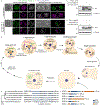Membrane-associated cytoplasmic granules carrying the Argonaute protein WAGO-3 enable paternal epigenetic inheritance in Caenorhabditis elegans
- PMID: 35132225
- PMCID: PMC9973253
- DOI: 10.1038/s41556-021-00827-2
Membrane-associated cytoplasmic granules carrying the Argonaute protein WAGO-3 enable paternal epigenetic inheritance in Caenorhabditis elegans
Abstract
Epigenetic inheritance describes the transmission of gene regulatory information across generations without altering DNA sequences, enabling offspring to adapt to environmental conditions. Small RNAs have been implicated in this, through both the oocyte and the sperm. However, as much of the cellular content is extruded during spermatogenesis, it is unclear whether cytoplasmic small RNAs can contribute to epigenetic inheritance through sperm. Here we identify a sperm-specific germ granule, termed the paternal epigenetic inheritance (PEI) granule, that mediates paternal epigenetic inheritance by retaining the cytoplasmic Argonaute protein WAGO-3 during spermatogenesis in Caenorhabditis elegans. We identify the PEI granule proteins PEI-1 and PEI-2, which have distinct functions in this process: granule formation, Argonaute selectivity and subcellular localization. We show that PEI granule segregation is coupled to the transport of sperm-specific secretory vesicles through PEI-2 in an S-palmitoylation-dependent manner. PEI-like proteins are found in humans, suggesting that the identified mechanism may be conserved.
© 2022. The Author(s), under exclusive licence to Springer Nature Limited.
Figures


















Comment in
-
Sperm granules mediate epigenetic inheritance.Nat Cell Biol. 2022 Feb;24(2):129-130. doi: 10.1038/s41556-021-00832-5. Nat Cell Biol. 2022. PMID: 35132226 Free PMC article.
References
MAIN MANUSCRIPT REFERENCES
-
- Bošković A & Rando OJ Transgenerational epigenetic inheritance. Annu. Rev. Genet 52, 21–41 (2018). - PubMed
-
- Hutvagner G & Simard MJ Argonaute proteins: Key players in RNA silencing. Nat. Rev. Mol. Cell Biol 9, 22–32 (2008). - PubMed
-
- Peters L & Meister G Argonaute Proteins: Mediators of RNA Silencing. Mol. Cell 26, 611–623 (2007). - PubMed
-
- Xu F, Guang S & Feng X Distinct nuclear and cytoplasmic machineries cooperatively promote the inheritance of RNAi in Caenorhabditis elegans. Biol. Cell 110, 217–224 (2018). - PubMed
METHOD REFERENCES
Publication types
MeSH terms
Substances
Grants and funding
LinkOut - more resources
Full Text Sources
Other Literature Sources
Research Materials

